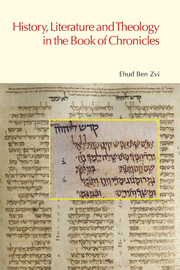Book contents
- Frontmatter
- Dedication
- Contents
- Acknowledgments
- Abbreviations
- Part I INTRODUCTORY ESSAYS
- Part II CHRONICLES AND THE REREADING AND WRITING OF A DIDACTIC, SOCIALIZING HISTORY
- Part III CHRONICLES AND THEOLOGY AS COMMUNICATED AND RECREATED THROUGH THE REREADING OF A HISTORIOGRAPHICAL, LITERARY WRITING
- Chapter 8 A SENSE OF PROPORTION: AN ASPECT OF THE THEOLOGY OF THE CHRONICLER
- Chapter 9 OBSERVATIONS ON WOMEN IN THE GENEALOGIES OF 1 CHRONICLES 1–9
- Chapter 10 IDEOLOGICAL CONSTRUCTIONS OF NON-YEHUDITE/PERIPHERAL ISRAEL IN ACHAEMENID YEHUD: THE CASE OF THE BOOK OF CHRONICLES
- Chapter 11 A GATEWAY TO THE CHRONICLER'S TEACHING: THE ACCOUNT OF THE REIGN OF AHAZ IN 2 CHRONICLES 28.1–27
- Chapter 12 THE AUTHORITY OF 1–2 CHRONICLES IN THE LATE SECOND TEMPLE PERIOD
- Part IV CHRONICLES AND LITERATURE: LITERARY CHARACTERIZATIONS THAT CONVEY THEOLOGICAL WORLDVIEWS AND SHAPE STORIES ABOUT THE PAST
- Bibliography
- Index of Biblical Works Cited
- Index of Authors and Individuals Cited
Chapter 9 - OBSERVATIONS ON WOMEN IN THE GENEALOGIES OF 1 CHRONICLES 1–9
from Part III - CHRONICLES AND THEOLOGY AS COMMUNICATED AND RECREATED THROUGH THE REREADING OF A HISTORIOGRAPHICAL, LITERARY WRITING
- Frontmatter
- Dedication
- Contents
- Acknowledgments
- Abbreviations
- Part I INTRODUCTORY ESSAYS
- Part II CHRONICLES AND THE REREADING AND WRITING OF A DIDACTIC, SOCIALIZING HISTORY
- Part III CHRONICLES AND THEOLOGY AS COMMUNICATED AND RECREATED THROUGH THE REREADING OF A HISTORIOGRAPHICAL, LITERARY WRITING
- Chapter 8 A SENSE OF PROPORTION: AN ASPECT OF THE THEOLOGY OF THE CHRONICLER
- Chapter 9 OBSERVATIONS ON WOMEN IN THE GENEALOGIES OF 1 CHRONICLES 1–9
- Chapter 10 IDEOLOGICAL CONSTRUCTIONS OF NON-YEHUDITE/PERIPHERAL ISRAEL IN ACHAEMENID YEHUD: THE CASE OF THE BOOK OF CHRONICLES
- Chapter 11 A GATEWAY TO THE CHRONICLER'S TEACHING: THE ACCOUNT OF THE REIGN OF AHAZ IN 2 CHRONICLES 28.1–27
- Chapter 12 THE AUTHORITY OF 1–2 CHRONICLES IN THE LATE SECOND TEMPLE PERIOD
- Part IV CHRONICLES AND LITERATURE: LITERARY CHARACTERIZATIONS THAT CONVEY THEOLOGICAL WORLDVIEWS AND SHAPE STORIES ABOUT THE PAST
- Bibliography
- Index of Biblical Works Cited
- Index of Authors and Individuals Cited
Summary
Although these chapters contain numerous references to males, they also contain references to more than 50 different women, named or unnamed. These references construe women as fulfilling a variety of roles in society, and characterize and identify them in various ways. Although the text was (most likely) written by male literati for male literati and reflects a patriarchal point of view, it contains references that indicated to the ancient readers of the book that ideologically construed gender expectations may and have been transgressed in the past and with good results. The goal of this article is to advance preliminary, basic observations about some of these references to women in the genealogical lists, within the historical context of the society for which the book of Chronicles was composed. It is our hope that by doing so, this paper will lead to future, more detailed studies on these topics.
For the purpose of the present endeavor, it seems heuristically helpful to classify the roles assigned to women in 1 Chronicles 1–9 into two categories: (a) those in which they are involved in lineage roles often associated with female members of an ancient household and (b) those representing roles that were commonly assigned to mature males in the society in general, or in their household. It should be stressed already that the borders between (a) and (b) are represented as porous in Chronicles.
- Type
- Chapter
- Information
- History, Literature and Theology in the Book of Chronicles , pp. 174 - 194Publisher: Acumen PublishingPrint publication year: 2006



